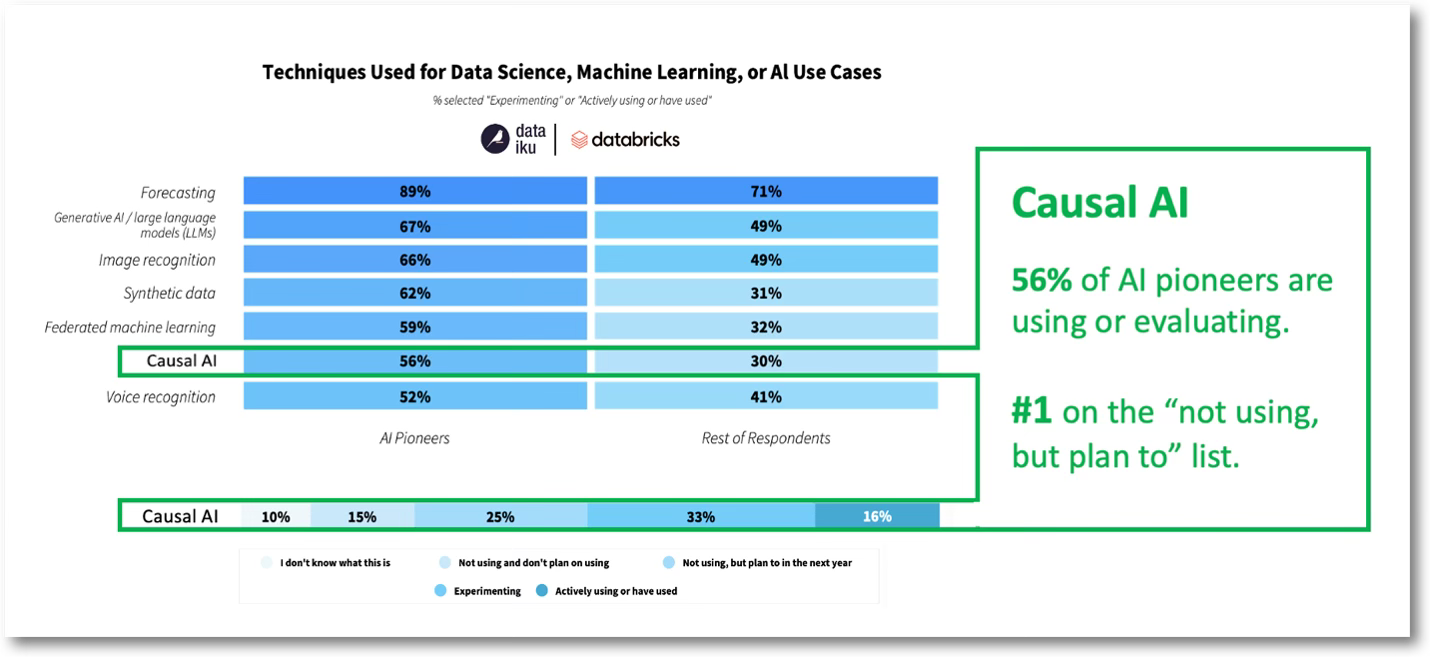There is a missing ingredient in today’s AI, which, when added, will make AI a truly indispensable partner in business and increase ROI over the long haul. The missing ingredient is CAUSALITY and the science of WHY.
This article summarizes a research note posted on theCUBE Research. It is the first in a series exploring the emerging marketplace for Causal AI platforms and tools. Read the full research note here.
You can also watch a brief discussion on the topic here:
Introduction
The rise of causalAI will enable new high-ROI use cases within existing AI systems and future AI architectures. The combination of agentic AI, causal reasoning, and interactive explainability, supported by a network of LLMs and SLMs, will define the next frontier of AI in business.
LLMs deliver generally applicable generative AI services
SLMs deliver small, specialized, and sovereign domain-specific models
Causal models infuse new levels of dynamic decision-intelligence
AI Agents support humans in solving problems and executing tasks
These future-state architectures will orchestrate an ecosystem of collaborating AI agents and models that will help humans problem-solve and make better decisions. They will also continuously teach each other to improve outcomes learned from real-world, outcome-based experiences. Causal AI will play a critical role in these architectures.
Furthermore, in the near term, the causal toolkit will help businesses progressively improve the outcomes rendered from today’s correlative AI models (Gen AI, LLMs, Predictive AI, etc.), which operate based on statistical probabilities but often lack any genuine causal understanding. As a result, they cannot truly understand the dynamic nature of how a business operates, creates value, and engages the world.
Despite that, today’s LLMs and generative AI are highly complex. However, those in the middle of implementing causality in AI would tell you that it’s complex on a whole other level, involving the algorithmic application of some super eloquent math and statistical theory.
Fortunately, as we will discuss, an increasing number of software companies are making significant strides in simplifying the use of causal AI for the masses. So, despite the almost unimaginable complexity behind the scenes, incorporating causality into today’s AI environment may be simpler than we realize and will likely become even easier over time.
The Emerging Marketplace
While today’s AI is super impressive, AI is only in its infancy, and most lack the more capable algorithmic “brains” known as machine learning (ML).
Of those who have adopted ML, 80% rely on the least sophisticated techniques and can only perform narrowly defined tasks.
The global machine learning platform and tool market is expected to reach $420 billion by 2030, with a compound annual growth rate (CAGR) of 35%. Despite the increased investment in AI, businesses still face limitations with today’s AI technology. According to a 2023 survey conducted by Rexer Analytics, less than half of enterprise machine learning projects make it into full production due to their inability to adapt to changing conditions and lack of trust and explainability.
The emerging Causal AI marketplace aims to address the limitations of current LLMs and generative AI solutions. This is particularly crucial for high ROI use cases that depend on root cause detection, decision intelligence, problem-solving, and autonomous action. AI professionals working on these cases recognize that integrating causality into the AI model lifecycle is essential for accurately modeling the dynamic business world and improving AI trust, transparency, and explainability.
The marketplace is speaking louder and louder.
A survey of 400 senior AI professionals provided by Databricks showed that among AI pioneering companies, 56% were already using or experimenting with Causal AI. In addition, among the total population of the survey, Causal AI was ranked as the #1 AI technology “not using, but plan to next year.” The study reported that 16% are already actively using causal methods, 33% are in the experimental stage, and 25% plan to adopt. Overall, 7 in 10 will adopt Causal AI techniques by 2026.
For example:
Georgia Pacific achieved a 10x increase in touchless order throughput by using causal AI to create a more seamless and adaptable order management process. They accomplished this by applying causal AI techniques to navigate the complexities of order management with greater precision, unraveling the cause-and-effect relationships to understand better how the business operates.
McCann Worldgroup, a global leader in marketing strategies, achieved a 5–10% uplift in brand purchase intent by identifying causal drivers of complex and highly dynamic purchasing behaviors. Additionally, they were able to apply counterfactual reasoning to predict better the impact of potential initiatives and changes in consumer attitudes, offering a forward-looking view on brand strategy
Urban Company, a marketplace that connects consumers needing home services with trained professionals, has achieved more precise and accurate estimates of what affects its customers’ lifetime value metrics. This, in turn, allows them to apply “what if” interventions that quantitatively rank the impact of various actions, enabling them to optimize retention strategies.
Instana, a provider of application performance and observability solutions, has applied causal AI to identify probable root causes as part of an intelligent incident remediation process. This allows SREs to resolve incidents by directly looking at the source of the problem instead of symptoms, saving them many hours of investigative work and reducing delays and costs to address the incident.
I believe that the aggregate market impact of causal AI on business will be far greater than the $1B marketplace (41% CAGR through 2030) indicated by today’s studies. In fact, we would not be surprised to see a similar dynamic to how generative AI well outperformed its initial market growth projections.
It’s worth noting that numerous companies are already in this market, with hundreds, if not thousands, of customers. They are committed to providing both general-purpose and domain-specific causal AI tools and platforms, making AI causality’s high-ROI potential accessible to everyday businesses.
For example:
causaLens decisionOS provides a causal AI platform that automates the end-to-end data-to-decision workflow. The platform simplifies the entire process, starting from data ingestion to generating actionable insights that comprehend cause and effect. Their approach involves using AI agents to help businesses identify causal business drivers, develop causal AI models, and implement them through decision agents. Additionally, the platform offers pre-built, customizable use cases and tools for integration with LLMs and Gen AI.
Geminos Causeway offers a powerful, low-code platform for developing Causal AI apps and Causal Digital Twins that can determine the reasons behind certain events. Causeway is based on open-source technology and offers a simplified solution for modeling causation and knowledge, along with advanced tools for causal analysis such as outlier, intervention, and root-cause analysis. It also accelerates ETL (Extract, Transform, Load) and data wrangling through more than 4,000 integrations, as well as the ability to enhance LLMs (Learning and Logic Models) and GenAI (Generalized Artificial Intelligence) investments.
Causal-rnb’s Ari platform offers a cloud-based augmented intelligence platform that leverages causal ML techniques to simplify how businesses solve complex problems, particularly in the industrial sector. It streamlines the way business leaders perform data analysis, gather insights, and tackle challenges. Ari enhances human intelligence by elucidating intricate data relationships and extracting actionable recommendations from vast datasets. It integrates causal discovery, causal inferencing, domain knowledge, and the development of decision-making apps into a unified experience, enabling the discovery and interpretation of cause-and-effect relationships between variables within a complex system.
CausaDB helps businesses understand how their systems and workflows function and provides guidance on the best actions to achieve improved outcomes. The tools provide a simple interface for creating, managing, and deploying causal AI models and integrating them into existing software stacks with minimal effort. They have prioritized simplicity, ease of use, and speed, allowing your team to focus on what truly matters with smaller datasets.
HowSo offers solutions that maximize AI return on investment (ROI) and reduce risks associated with traditional AI approaches through its Understandable AI® Platform. This platform provides benefits such as a data-driven approach, transparency, auditability, and bias reduction. It combines causal AI, synthetic data, attribution inferencing, model monitoring, and data insights into one integrated experience. The platform identifies causal relationships within datasets and quantifies cause-and-effect relationships through advanced causal inference and simulations, helping businesses make better decisions.
These are just a handful of solution providers in the marketplace today, and we fully anticipate that many more new entrants will soon emerge.
What to Do
Causal AI is a significant advancement in the ongoing progression of AI. The current correlative-based designs have limitations that will eventually hinder the development of new innovations.
As Microsoft Research has recently stated — “Causal machine learning is poised to be the next AI revolution.” While it may not be a revolution, it is certainly necessary and inevitable. It’s just a matter of time before it becomes mainstream.
Perhaps the time is now to start preparing for this new frontier in AI. As we have witnessed in past technological evolutions, some will lead, some will lag, and some will eventually fail.
As it’s never too early to start the evaluation process and run experiments, I’d recommendation you:
● Build Casual AI Competency (and get certified)
● Evaluate potential use cases through experimentation
● Develop a future-state strategy and talent pool
● Contact me if I can help you on this journey
I’d also recommend watching the recent Breaking Analysis with Dave Vellante segment titled From LLMs to SLMs to SAMs: How Agents Are Redefining AI.
Also, if you are a user of OpenAI’s ChatGPT, you may also find this recent research note of interestest - OpenAI Advances AI Reasoning, But The Journey Has Only Begun.
Thanks for reading. Feedback is always appreciated.









